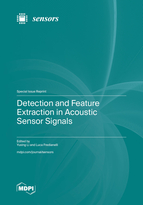Detection and Feature Extraction in Acoustic Sensor Signals
A special issue of Sensors (ISSN 1424-8220). This special issue belongs to the section "Physical Sensors".
Deadline for manuscript submissions: closed (20 August 2023) | Viewed by 17826
Special Issue Editors
Interests: fractal dimension; underwater signal processing; sensor signal processing; denoising; feature extraction; fault diagnosis; image processing
Special Issues, Collections and Topics in MDPI journals
Interests: environmental acoustics; noise mitigations; noise management; noise measurements; noise mapping; noise action plans; wind turbine noise; road traffic noise; railway noise; airport noise
Special Issues, Collections and Topics in MDPI journals
Special Issue Information
Dear Colleagues,
Acoustic sensors have an extremely wide range of applications in many fields, including underwater acoustics, architectural acoustics, engineering acoustics, physical acoustics, environmental acoustics, psychoacoustics, and so on. The signals collected by high-sensitivity acoustic sensors contain a large amount of valid information that facilitates further processing of the collected acoustic signals. In particular, detection and feature extraction, as two important measures of acoustic sensor signal processing, can capture more information about the target and extract features with separability.
Various trends indicate that detection as well as feature extraction play an increasingly important role in the processing of acoustic sensor signals, and the latest methods for acoustic signal detection or feature extraction are welcome in this Special Issue, such as the application of stochastic resonance in vibration signals, nonlinear feature extraction of underwater acoustic signals, and so on. We encourage all authors working on similar topics to submit their work to this Special Issue. Equally welcome are contributions from any field of acoustic sensors with applications in real-world data.
Dr. Yuxing Li
Dr. Luca Fredianelli
Guest Editors
Manuscript Submission Information
Manuscripts should be submitted online at www.mdpi.com by registering and logging in to this website. Once you are registered, click here to go to the submission form. Manuscripts can be submitted until the deadline. All submissions that pass pre-check are peer-reviewed. Accepted papers will be published continuously in the journal (as soon as accepted) and will be listed together on the special issue website. Research articles, review articles as well as short communications are invited. For planned papers, a title and short abstract (about 100 words) can be sent to the Editorial Office for announcement on this website.
Submitted manuscripts should not have been published previously, nor be under consideration for publication elsewhere (except conference proceedings papers). All manuscripts are thoroughly refereed through a single-blind peer-review process. A guide for authors and other relevant information for submission of manuscripts is available on the Instructions for Authors page. Sensors is an international peer-reviewed open access semimonthly journal published by MDPI.
Please visit the Instructions for Authors page before submitting a manuscript. The Article Processing Charge (APC) for publication in this open access journal is 2600 CHF (Swiss Francs). Submitted papers should be well formatted and use good English. Authors may use MDPI's English editing service prior to publication or during author revisions.
Keywords
- acoustic sensor signal feature extraction
- acoustic sensor signal detection
- acoustic sensor signal processing
- stochastic resonance in vibration signals
- nonlinear feature extraction of underwater acoustic signals
- heart rate state detection
- acoustic beamforming and the emerging field of acoustic cameras








